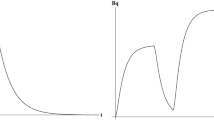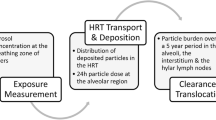Abstract
In most cases the measurement of radioactivity in an environmental or biological sample will be followed by some estimation of dose and possibly risk, either to a population or an individual. This will normally involve the use of a dose coefficient (dose per unit intake value) taken from a compendium. In recent years the calculation of dose coefficients has seen many developments in both biokinetic modelling and computational capabilities. ICRP has recommended new models for the respiratory tract and for the systemic behavior of many of the more important elements. As well as this, a general age-dependent calculation method has been developed which involves an effectively continuous variation of both biokinetic and dosimetric parameters, facilitating more realistic estimation of doses to young people. These new developments were used in work for recent ICRP, IAEA and CEC compendia of dose coefficients for both members of the public (including children) and workers. This paper presents a general overview of the method of calculation of internal doses with particular reference to the actinides. Some of the implications for dose coefficients of the new models are discussed. For example it is shown that compared with data in ICRP Publications 30 and 54: the new respiratory tract model generally predicts lower deposition in systemic tissues per unit intake; the new biokinetic models for actinides allow for burial of material deposited on bone surfaces; age-dependent models generally feature faster turnover of material in young people. All of these factors can lead to substantially different estimates of dose and examples of the new dose coefficients are given to illustrate these differences. During the development of the new models for actinides, human bioassay data were used to validate the model. Thus, one would expect the new models to give reasonable predictions of bioassay quantities. Some examples of the bioassay applications, e.g., excretion data for the plutonium model, are discussed briefly.
Similar content being viewed by others
References
ICRP, Human Respiratory Tract Model for Radiological Protection, ICRP Publication 66, Ann. ICRP, 24, Nos 1 to 3 (1994a).
ICRP, Age-Dependent Doses to Members of the Public from Intake of Radionuclides: Part 1. ICRP Publication 56, Ann. ICRP, 20, No 2 (1990).
ICRP, Age-Dependent Doses to Members of the Public from Intake of Radioniclides: Part 2, Ingestion Dose Coefficients, ICRP Publication 67, Ann. ICRP, 23, No 3/4 (1993).
ICRP, Age-Dependent Doses to Members of the Public from Intake of Radionuclides: Part 3, Ingestion Coefficients, ICRP Publication 69, Ann. ICRP, 23, No 1 (1995).
ICRP, Limits for Intakes of Radionuclides by Workers, ICRP Publication 30 Part 1, Ann. ICRP, 2, Nos 3 and 4 (1979).
ICRP, Dose Coefficients for Intakes of Radionuclides by Workers, Replacement of ICRP Publication 61, ICRP Publication 68, Ann. ICRP, 24, No. 4 (1994).
ICRP, The Metabolism of Plutonium and Related Elements, ICRP Publication 48, Ann. ICRP, 16, Nos 2-3 (1986).
ICRP, 1990 Recommendations of the International Commission on Radiological Protection, ICRP Publication 60. Ann. ICRP, 21, Nos 1-3 (1990).
IAEA, International Basic Safety Standards for Protection against Ionizing Radiation and for the Safety of Radiation Sources, Safety Series No. 115, IAEA, Vienna, 1996.
EU, Council Directive of the European Union Laying Down the Basic Safety Standards for the Protection of the Health of Workers and the General Public Against the Dangers Arising from Ionizing Radiation, 1996.
ICRP, Age-Dependent Doses to Members of the Public from Intake of Radionuclides: Part 4, Inhalation Dose Coefficients. ICRP Publication 71, Ann. ICRP, 25, No 3/4 (1995).
ICRP, Age-Dependent Doses to Members of the Public from Intake of Radionuclides: Part 5, Compilation of Ingestion and Inhalation Dose Coefficients, ICRP Publication 72 (1995, in press).
ICRP, Individual Monitoring for Intakes of Radionuclides by Workers: Design and Interpretation, ICRP Publication 54, Ann. ICRP, 19, No 1-3 (1988).
M. Cristy, K. F. Eckerman, Oak Ridge, Tennessee, Oak Ridge National Laboratory, ORNL/TM-8381/vl-7, 1987.
G. N. Stradling, P. G. Pellow, A. Hodgson, T. P. Fell, A. Phipps, M. Pearce, M. Taskaeva, I. Penev, T. Guentchev, J. Radioanal. Nucl. Chem., 226 (1997) 7.
P. G. Pellow, G. N. Stradling, A. Hodgson, T. P. Fell, A. Phipps, M. Ellender, J. Radioanal. Nucl. Chem., 226 (1997) 93.
G. N. Stradling, S. A. Hodgson, A. Hodgson, A. Phipps, T. Fell, J. C. Moody, P. Pellow, E. Rance, I. Buen, M. Pearce, E. Ellender, E. Iranzo, A. Espinosa, A. Aragon, Chilton: National Radiological Protection Board, NRPB-M692, 1996.
Author information
Authors and Affiliations
Rights and permissions
About this article
Cite this article
Fell, T.P., Phipps, A.W., Kendall, G.M. et al. Recent developments in biokinetic models and the calculation of internal dose coefficients. J Radioanal Nucl Chem 226, 109–115 (1997). https://doi.org/10.1007/BF02063633
Received:
Issue Date:
DOI: https://doi.org/10.1007/BF02063633




